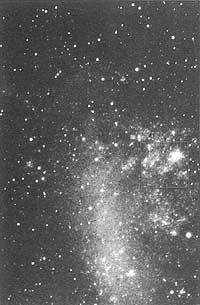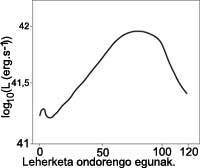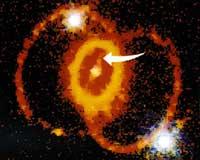5th Anniversary Supernova SN1987 A
1992/07/01 Arregi Bengoa, Jesus Iturria: Elhuyar aldizkaria
For some time we have not reported on the supernova SN1987 A, but due to the custom of celebrating human birthdays, with the excuse of the 5th birthday of the aforementioned supernova, several technical journals have published articles on the current state of research. Below are these interesting works, while “Elhuyar. Referring to the articles published in the journal “Science and Technology” on this subject.
The first mention we must make is the compact residue of the supernova. J in numbers 30 and 31. In Kristia and his companions we talked about the work that gave account of the discovery of the network of pulsations that was believed as a result of the explosion. It attaches two remarkable and surprising peculiarities to the possible network: the enormous spinning speed of 2,000 thirds (revolutions per second) and the sinusoidal variation of the frequency of radiation. The value of the spinning speed tripled the speed of the rapid impulses found until then.
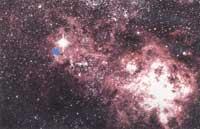
This value was unacceptable, but as we explained then, theories on the subject do not do it completely. Therefore, astrophysicists began to speculate with ultra-fast pulsars. Certainly these efforts will not be a work of misfortune, but today we know J. That the observations made by Kristian in January 1989 were interference generated by the telescope's television camera. After this error, we are as at first, although we know that it must be a neutron star or a black hole without great clues about the nature of the solid residue of the supernova.
As is known, 20 hours before finding the supernova, the batch of neutrinos per explosion was measured on Earth. Specifically, 20 neutrinos with energy between 6 and 39 MeV (megaelectron volt) were detected within 12 seconds. The values of the energies, as well as the duration of the beam, are very well adjusted to the state of the explosion, since they indicate that neutrinos have occurred in the region that was a few seconds at a temperature of 50,000 million K. These latter conditions are due to the contraction of the supernova star.
The detection took place in the US and Japan, on two very buried vessels. The latter are fraction detectors to demonstrate the disintegration of the proton. The 20 measured fractions are not representative of Earth's neutral oppression, as they are highly detectable. The visible light emission of the supernova is only 0.01% of the total energy released in the explosion. The rest is removed by neutrinos. Energy generated during the explosion 1.5 . It was 1051 euros. If we take into account that this energy is sufficient for the stars of our Galaxy to remain on for a few months, it is evident that the day on which neutrinos were detected, billions of them crossed us.
Let us leave for a moment the problems associated with the supernova, and mention the consequences that scientists working in the field of fractions physics, based on the peculiarities of detection, have achieved on the nature of neutrinos. The first evidence is derived from mere detection: The SN 1987 A supernova is 170,000 light-years away. Therefore, neutrinos have a minimum life of 170,000 years. Otherwise they could not have come.
Another detail is that corresponding to the load. If it had charge, it would disperse the magnetic fields of the galaxy. It has been seen that the load of neutrinos should be a thousand (10-12) times lower than that of the electron. In addition to the load, a limit has been set to the mass of neutrinos. If neutrinos had mass, their energy would limit the speed of each of them. As a result, the fastest would be ahead and the time between detection of these and the slower would be greater than a few seconds.
The 12-second period measured, after 170,000 years of travel, indicates that the neutrino mass must be very small. The latest calculations indicate that the upper limit would be 16 volts of electron, i.e. 30 million of the electron mass. This result responds to the more widespread opinion among physicists that neutrino has a null mass and moves at the speed of light (like photon).
The limit of mass is also important in the field of cosmology. The universe is full of neutrinos created by the Big Bang. Therefore, if in spite of their small size they had masses, their gravitational attraction would be enough to stop the expansion of the Universe. However, the new mass limit we have given before does not allow it.
Going back to the supernova, we will analyze another problem, which we had to leave unexplained in number 15 and which researchers have just clarified. The key is the nature of the star that created the supernova. As is known, the theory of supernovae distinguishes two types of supernovae: Types I and II were classified within the second class SN1987 A (II), as it presented a spectrum similar to that of this group, i.e. with clear hydrogen lines. The surprise arises when analyzing the photos of the original star, Sanduleak (69°222).
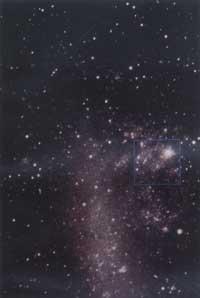
It was commonly accepted that type II supernovae were produced as a result of the explosion of red giant stars. However, the star -69°222 was a blue giant spectral type B3. Its radius ~3.107 km was about 50 times that of the Sun, but much smaller than that of a red supergiant. The mass was 20 times larger than that of the Sun.
The situation created gave rise to studies on the evolution of massive stars and the solution has been found taking into account the difference between the compositions of the French Way and the Great Cloud of Magellan. In the Great Magellanic Cloud the proportion of heavy elements is lower than in our Galaxy. In the case of a normal star, the percentage of heavy elements is estimated at one-third of the total Sun. Heavy elements are absorbent from radiation from the center of the star.
As a result, the outer layers of the star are heated and expanded. With expansion cool and redden. As in the case of the Great Magellanic Cloud, if the proportion of heavy elements is low, the radiation is ejected more easily and then the passage to the red supergiant is not essential. Moreover, although the star becomes a red supergiant, it can return to the situation of the blue giant, losing the outer layers of gas. This is what is believed to have happened to the star that we are studying about 10,000 years before the explosion.
This theory we have just explained has in its favor some observations made by the Hubble Space Telescope. Around the supernova has found a light ring visible from Earth, a radio ring of one-third of a year of light. It is believed that the ring is formed by the fractional wind that gives the stars. In a supergiant state this wind is faster at the poles than at the equator. Consequently, it creates a structure of matter in the form of a hourglass. When the star returns to the blue giant's situation, the wind also changes, making it faster and faster. When this wind finds the waist of the hourglass of higher density, it compresses more forming the ring.
In the following issue we will analyze other problems of interest around the SN1987.
February 2015 SUN: On July 22, at 14 h 8 min, the Sun enters the constellation of Leo.
PLANETS
|
August Anniversaries SUN: on the 22nd at 21h 10min enters Virgo.
PLANETS
|

Gai honi buruzko eduki gehiago
Elhuyarrek garatutako teknologia



